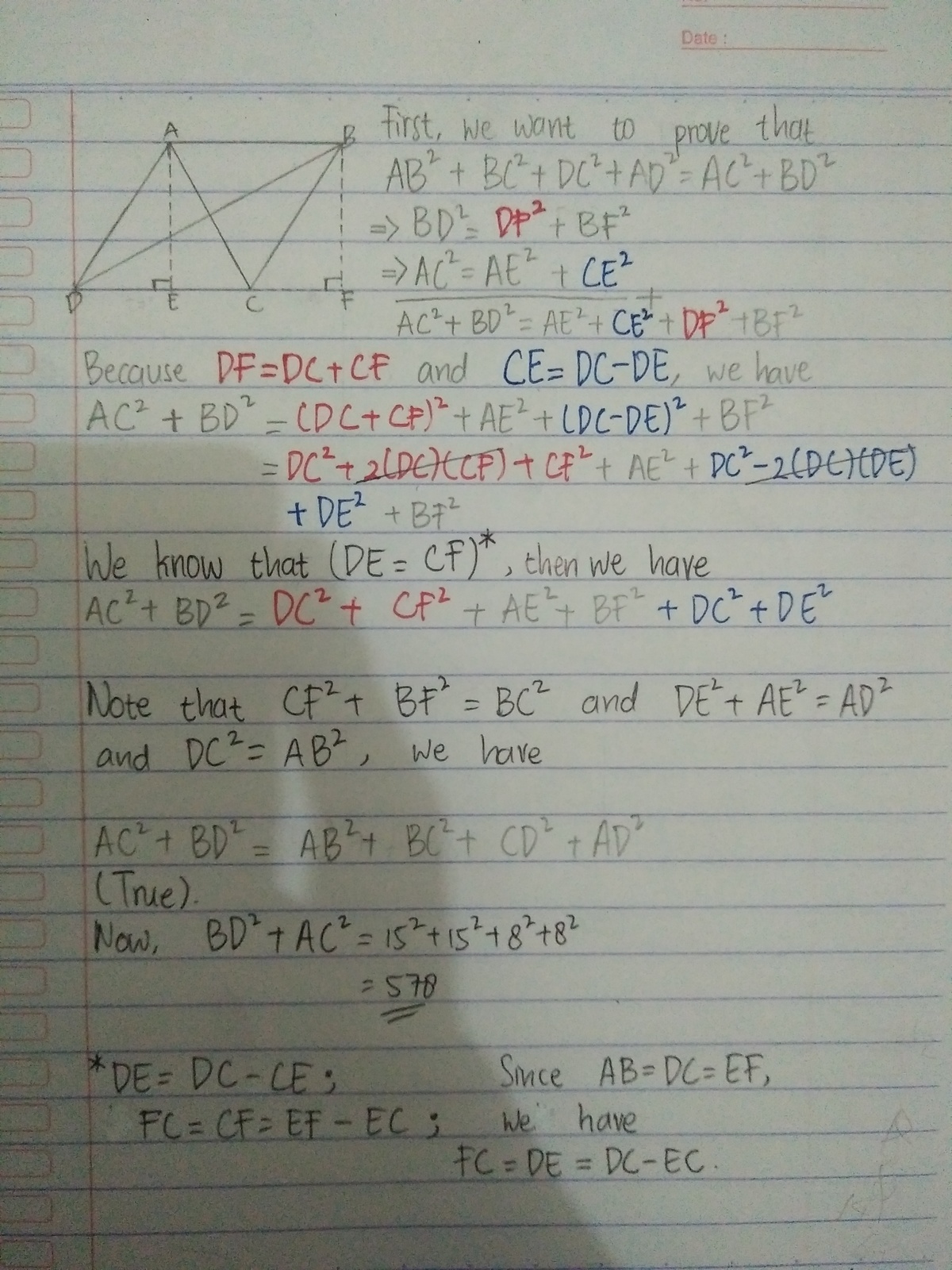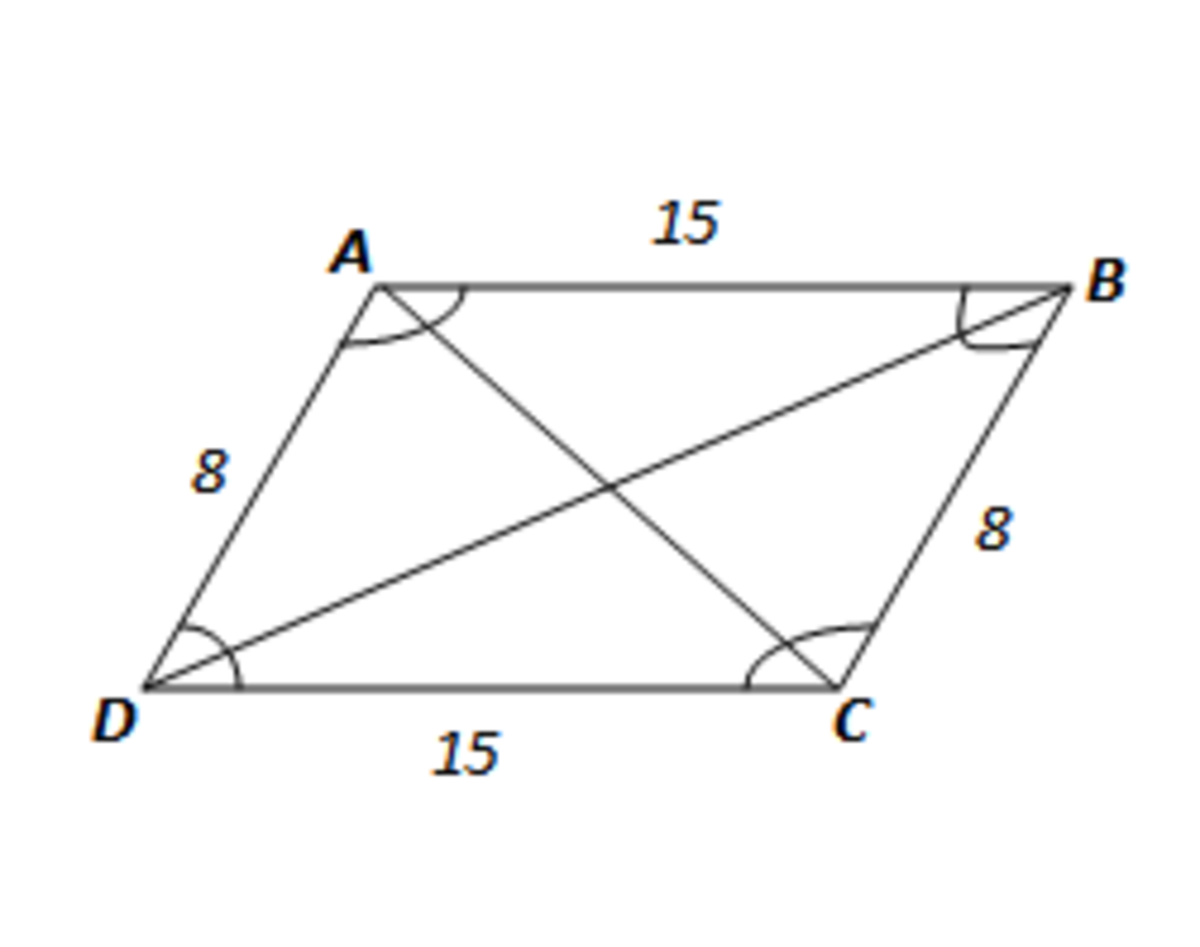Parallelogram and its diagonal
The lengths of two adjacent sides of a parallelogram are 8 and 15, respectively.
Find the sum of squares of the lengths of the two diagonals.
The answer is 578.
This section requires Javascript.
You are seeing this because something didn't load right. We suggest you, (a) try
refreshing the page, (b) enabling javascript if it is disabled on your browser and,
finally, (c)
loading the
non-javascript version of this page
. We're sorry about the hassle.
9 solutions

Actually, this problem is very easy, if you already know this proof. And I already knew this proof, so I shared this proof, to make this problem easier.
The proof is very easy if you know the cosine rule. ;)
Log in to reply
But, i'd rather choose Pythagorean Theorem. I don't know why, but i love to prove it with Pythagorean Theorem..
Nice way of proving it!
The Pythagorean theorem is more fundamental than the Cosine rule, so it's good to know that we can approach this just using Pythagorean Theorem.
Using the cosine law:
( DB )^2 = (15)^2 + (8)^2 +2(15)(8) cos C ( AC )^2 = (15)^2 + (8)^2 +2(15)(8) cos D

Also, take note that consecutive angles in a parallelogram are supplementary.
( DB )^2 = 289+240 cos C ( AC )^2 = 289+240 cos D ( AC )^2 = 289+240 cos(180 - C ) ( AC )^2 = 289+240 (-cos C ) ( AC )^2 = 289-240 cos C ( DB )^2 + ( AC )^2 = 289 + 240 cos C + 289 - 240 cos C =578
No i have done it in easier way :D
Log in to reply
Can you show it? I want to know a new but short solution for this problem.
For this question to work the answer must be independent of the angle between adjacent sides. Thus the answer is the same for a rectangle 2 x (15² + 8²) = 578, or the degenerate line case of (15-8)² + (15+8)² = 578. So the answer is 578.
According to the parallelogram law, the sum of the squares of the lengths of the four sides of a parallelogram equals the sum of the squares of the lengths of the two diagonals. So the desired answer is 2 ( 8 2 ) + 2 ( 1 5 2 ) = 5 7 8 .
Just using specializations, the rectangle is also parallelogram.and as you like, 578 is the answer.

Let x = shorter diagonal and y = longer diagonal
By applying cosine law in my figure, we have
x 2 = 8 2 + 1 5 2 − 2 ( 8 ) ( 1 5 ) ( c o s A ) = 2 8 9 − 2 4 0 c o s A
Similarly,
y 2 = 8 2 + 1 5 2 − 2 ( 8 ) ( 1 5 ) ( c o s B ) = 2 8 9 − 2 4 0 c o s B
Now we add the squares of the two diagonals,
x 2 + y 2 = 5 7 8 − 2 4 0 c o s A − 2 4 0 c o s B = 5 7 8 − 2 4 0 ( c o s A + c o s B )
The sum of < A and < B is 1 8 0 , so c o s A + c o s B = 0 .
Thus, we have
x 2 + y 2 = 5 7 8
2 x (15² + 8²) = 578 = d^2 + d^2
Draw a line from B to DC perpendicularly, intersects DC at E, and the length of this line is b. Draw also from C to AB.Let CE=a.
Pythagoras : a^2 + b^2 = 8^2 ... (1),
(15+a)^2 + b^2 = BD^2 ... (2),
(15-a)^2 + b^2 = AC^2 .....(3),
(2) + (3), and by replacing a^2 + b^2 = 8^2 , we have 2(15^2 + 8^2) = BD^2 + AC^2 .
So the sum of the squares of the diagonals of the parallelogram = 578
Let ∠ A D C = ∠ A B C = θ , then ∠ D A B = ∠ B C D = 1 8 0 ∘ − θ . By cosine rules,
A C 2 + B D 2 = A D 2 + D C 2 − 2 A D ⋅ D C cos ( ∠ A D C ) + A D 2 + A B 2 − 2 A D ⋅ A B cos ( ∠ D A B ) = 8 2 + 1 5 2 − 2 ⋅ 8 ⋅ 1 5 cos θ + 8 2 + 1 5 2 − 2 ⋅ 8 ⋅ 1 5 cos ( 1 8 0 ∘ − θ ) = 8 2 + 1 5 2 − 2 ⋅ 8 ⋅ 1 5 cos θ + 8 2 + 1 5 2 + 2 ⋅ 8 ⋅ 1 5 cos θ = 8 2 + 1 5 2 + 8 2 + 1 5 2 = 5 7 8 As cos ( 1 8 0 ∘ − θ ) = − cos θ